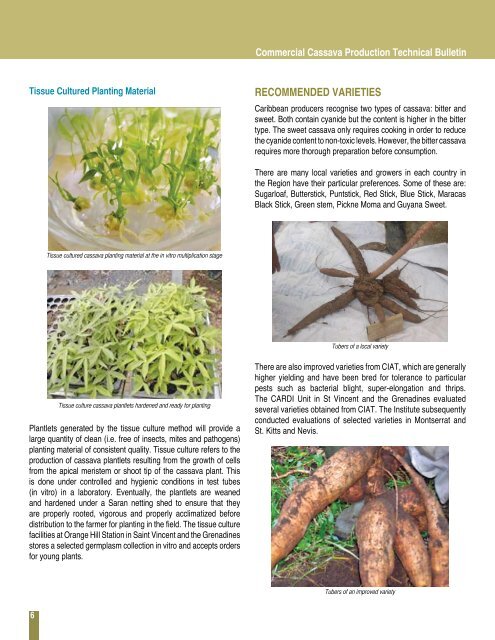Commercial-Cassava-Production-Technical_Bulletin-Final
Commercial-Cassava-Production-Technical_Bulletin-Final
Commercial-Cassava-Production-Technical_Bulletin-Final
Create successful ePaper yourself
Turn your PDF publications into a flip-book with our unique Google optimized e-Paper software.
<strong>Commercial</strong> <strong>Cassava</strong> <strong>Production</strong> <strong>Technical</strong> <strong>Bulletin</strong>Tissue Cultured Planting MaterialRECOMMENDED VARIETIESCaribbean producers recognise two types of cassava: bitter andsweet. Both contain cyanide but the content is higher in the bittertype. The sweet cassava only requires cooking in order to reducethe cyanide content to non-toxic levels. However, the bitter cassavarequires more thorough preparation before consumption.There are many local varieties and growers in each country inthe Region have their particular preferences. Some of these are:Sugarloaf, Butterstick, Puntstick, Red Stick, Blue Stick, MaracasBlack Stick, Green stem, Pickne Moma and Guyana Sweet.Tissue cultured cassava planting material at the in vitro multiplication stageTubers of a local varietyTissue culture cassava plantlets hardened and ready for plantingPlantlets generated by the tissue culture method will provide alarge quantity of clean (i.e. free of insects, mites and pathogens)planting material of consistent quality. Tissue culture refers to theproduction of cassava plantlets resulting from the growth of cellsfrom the apical meristem or shoot tip of the cassava plant. Thisis done under controlled and hygienic conditions in test tubes(in vitro) in a laboratory. Eventually, the plantlets are weanedand hardened under a Saran netting shed to ensure that theyare properly rooted, vigorous and properly acclimatized beforedistribution to the farmer for planting in the field. The tissue culturefacilities at Orange Hill Station in Saint Vincent and the Grenadinesstores a selected germplasm collection in vitro and accepts ordersfor young plants.There are also improved varieties from CIAT, which are generallyhigher yielding and have been bred for tolerance to particularpests such as bacterial blight, super-elongation and thrips.The CARDI Unit in St Vincent and the Grenadines evaluatedseveral varieties obtained from CIAT. The Institute subsequentlyconducted evaluations of selected varieties in Montserrat andSt. Kitts and Nevis.Tubers of an improved variety6


